BSc BMP4005: Big Data Analysis & its Support to Business
VerifiedAdded on 2023/06/09
|11
|3075
|218
Report
AI Summary
This report provides an overview of information systems and big data analytics, including the characteristics of big data, the challenges in its analysis, and the techniques available for analyzing it. It discusses the five characteristics of big data: variety, volume, value, velocity, and veracity. The report also outlines challenges such as data combination, privacy, accuracy, lack of understanding, storage, and integration. It further explores techniques like machine learning, data mining, associative techniques, fixed investigative techniques, A/B testing, and statistics. The report highlights how big data technology supports business by identifying new revenue sources and improving marketing strategies, enabling companies to grow rapidly and leverage market potential effectively.
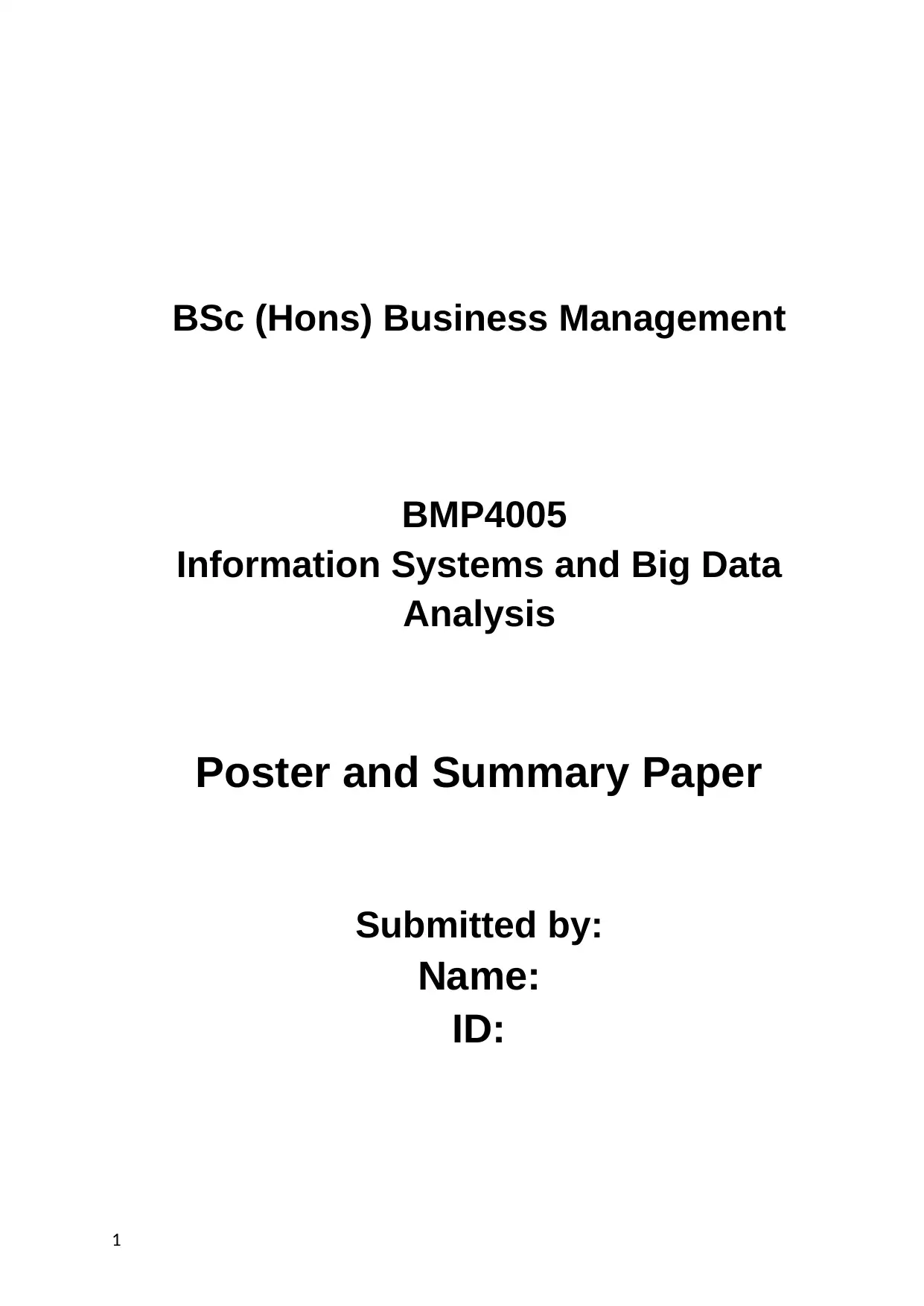
BSc (Hons) Business Management
BMP4005
Information Systems and Big Data
Analysis
Poster and Summary Paper
Submitted by:
Name:
ID:
1
BMP4005
Information Systems and Big Data
Analysis
Poster and Summary Paper
Submitted by:
Name:
ID:
1
Paraphrase This Document
Need a fresh take? Get an instant paraphrase of this document with our AI Paraphraser
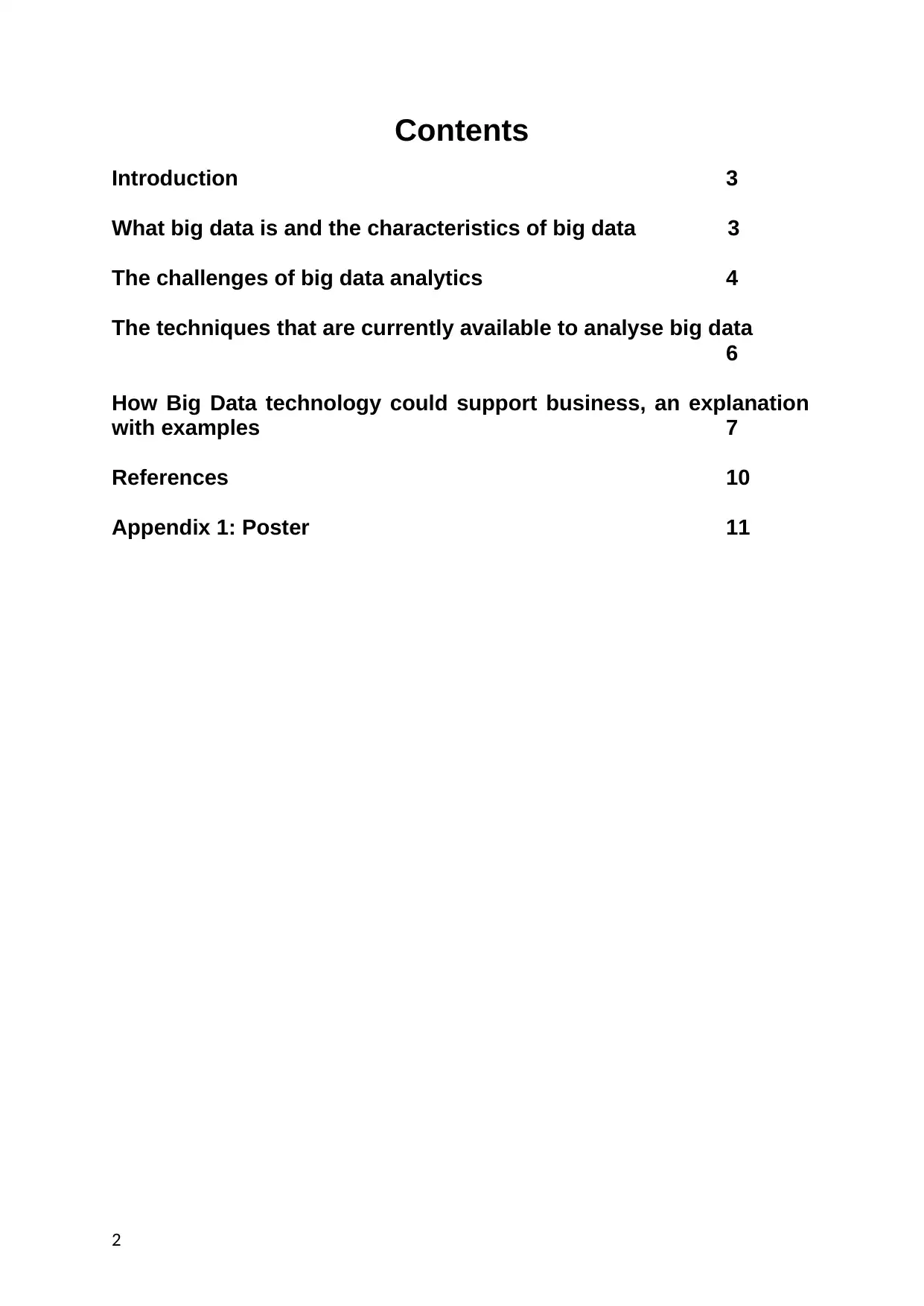
Contents
Introduction 3
What big data is and the characteristics of big data 3
The challenges of big data analytics 4
The techniques that are currently available to analyse big data
6
How Big Data technology could support business, an explanation
with examples 7
References 10
Appendix 1: Poster 11
2
Introduction 3
What big data is and the characteristics of big data 3
The challenges of big data analytics 4
The techniques that are currently available to analyse big data
6
How Big Data technology could support business, an explanation
with examples 7
References 10
Appendix 1: Poster 11
2
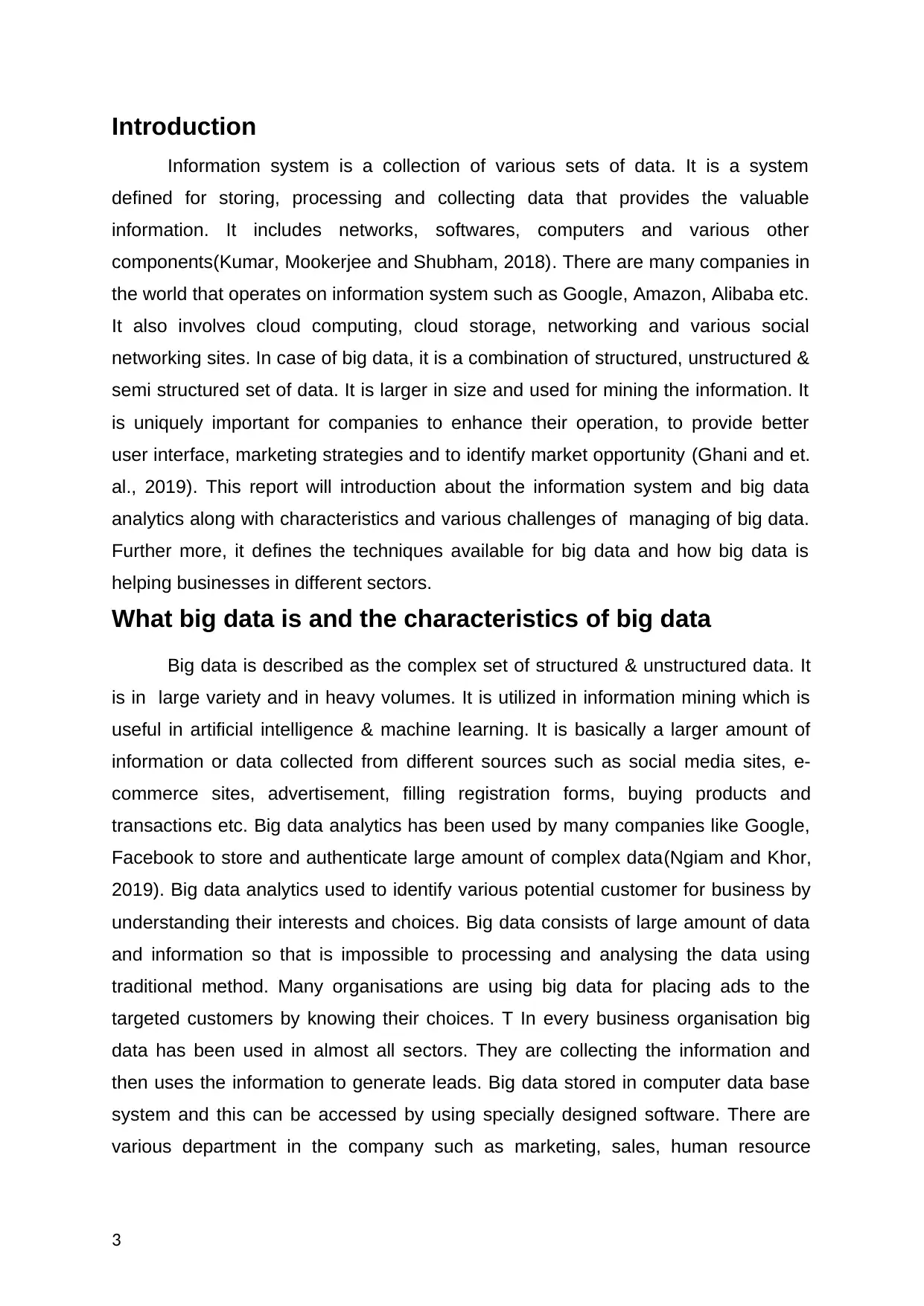
Introduction
Information system is a collection of various sets of data. It is a system
defined for storing, processing and collecting data that provides the valuable
information. It includes networks, softwares, computers and various other
components(Kumar, Mookerjee and Shubham, 2018). There are many companies in
the world that operates on information system such as Google, Amazon, Alibaba etc.
It also involves cloud computing, cloud storage, networking and various social
networking sites. In case of big data, it is a combination of structured, unstructured &
semi structured set of data. It is larger in size and used for mining the information. It
is uniquely important for companies to enhance their operation, to provide better
user interface, marketing strategies and to identify market opportunity (Ghani and et.
al., 2019). This report will introduction about the information system and big data
analytics along with characteristics and various challenges of managing of big data.
Further more, it defines the techniques available for big data and how big data is
helping businesses in different sectors.
What big data is and the characteristics of big data
Big data is described as the complex set of structured & unstructured data. It
is in large variety and in heavy volumes. It is utilized in information mining which is
useful in artificial intelligence & machine learning. It is basically a larger amount of
information or data collected from different sources such as social media sites, e-
commerce sites, advertisement, filling registration forms, buying products and
transactions etc. Big data analytics has been used by many companies like Google,
Facebook to store and authenticate large amount of complex data(Ngiam and Khor,
2019). Big data analytics used to identify various potential customer for business by
understanding their interests and choices. Big data consists of large amount of data
and information so that is impossible to processing and analysing the data using
traditional method. Many organisations are using big data for placing ads to the
targeted customers by knowing their choices. T In every business organisation big
data has been used in almost all sectors. They are collecting the information and
then uses the information to generate leads. Big data stored in computer data base
system and this can be accessed by using specially designed software. There are
various department in the company such as marketing, sales, human resource
3
Information system is a collection of various sets of data. It is a system
defined for storing, processing and collecting data that provides the valuable
information. It includes networks, softwares, computers and various other
components(Kumar, Mookerjee and Shubham, 2018). There are many companies in
the world that operates on information system such as Google, Amazon, Alibaba etc.
It also involves cloud computing, cloud storage, networking and various social
networking sites. In case of big data, it is a combination of structured, unstructured &
semi structured set of data. It is larger in size and used for mining the information. It
is uniquely important for companies to enhance their operation, to provide better
user interface, marketing strategies and to identify market opportunity (Ghani and et.
al., 2019). This report will introduction about the information system and big data
analytics along with characteristics and various challenges of managing of big data.
Further more, it defines the techniques available for big data and how big data is
helping businesses in different sectors.
What big data is and the characteristics of big data
Big data is described as the complex set of structured & unstructured data. It
is in large variety and in heavy volumes. It is utilized in information mining which is
useful in artificial intelligence & machine learning. It is basically a larger amount of
information or data collected from different sources such as social media sites, e-
commerce sites, advertisement, filling registration forms, buying products and
transactions etc. Big data analytics has been used by many companies like Google,
Facebook to store and authenticate large amount of complex data(Ngiam and Khor,
2019). Big data analytics used to identify various potential customer for business by
understanding their interests and choices. Big data consists of large amount of data
and information so that is impossible to processing and analysing the data using
traditional method. Many organisations are using big data for placing ads to the
targeted customers by knowing their choices. T In every business organisation big
data has been used in almost all sectors. They are collecting the information and
then uses the information to generate leads. Big data stored in computer data base
system and this can be accessed by using specially designed software. There are
various department in the company such as marketing, sales, human resource
3
⊘ This is a preview!⊘
Do you want full access?
Subscribe today to unlock all pages.

Trusted by 1+ million students worldwide
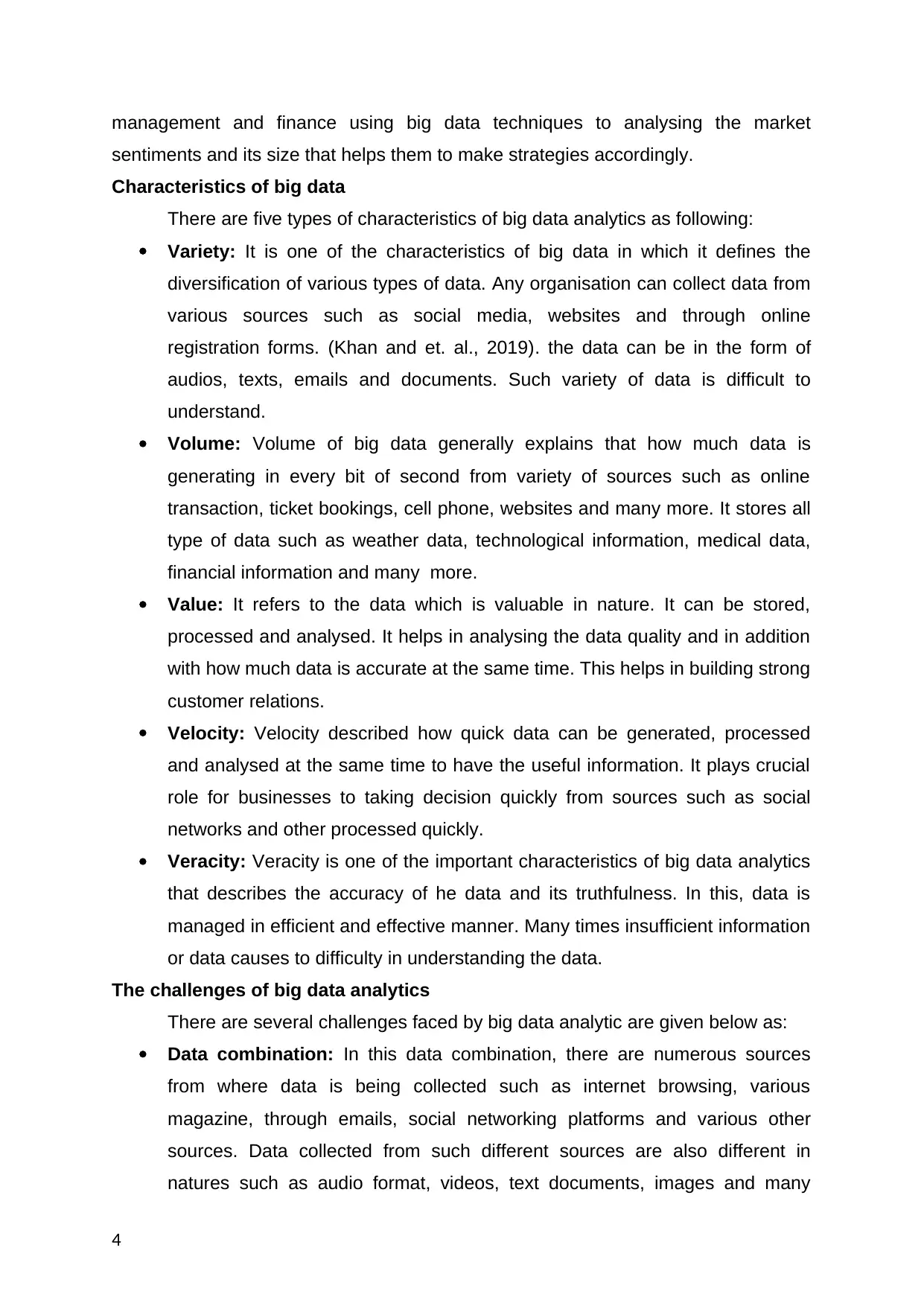
management and finance using big data techniques to analysing the market
sentiments and its size that helps them to make strategies accordingly.
Characteristics of big data
There are five types of characteristics of big data analytics as following:
Variety: It is one of the characteristics of big data in which it defines the
diversification of various types of data. Any organisation can collect data from
various sources such as social media, websites and through online
registration forms. (Khan and et. al., 2019). the data can be in the form of
audios, texts, emails and documents. Such variety of data is difficult to
understand.
Volume: Volume of big data generally explains that how much data is
generating in every bit of second from variety of sources such as online
transaction, ticket bookings, cell phone, websites and many more. It stores all
type of data such as weather data, technological information, medical data,
financial information and many more.
Value: It refers to the data which is valuable in nature. It can be stored,
processed and analysed. It helps in analysing the data quality and in addition
with how much data is accurate at the same time. This helps in building strong
customer relations.
Velocity: Velocity described how quick data can be generated, processed
and analysed at the same time to have the useful information. It plays crucial
role for businesses to taking decision quickly from sources such as social
networks and other processed quickly.
Veracity: Veracity is one of the important characteristics of big data analytics
that describes the accuracy of he data and its truthfulness. In this, data is
managed in efficient and effective manner. Many times insufficient information
or data causes to difficulty in understanding the data.
The challenges of big data analytics
There are several challenges faced by big data analytic are given below as:
Data combination: In this data combination, there are numerous sources
from where data is being collected such as internet browsing, various
magazine, through emails, social networking platforms and various other
sources. Data collected from such different sources are also different in
natures such as audio format, videos, text documents, images and many
4
sentiments and its size that helps them to make strategies accordingly.
Characteristics of big data
There are five types of characteristics of big data analytics as following:
Variety: It is one of the characteristics of big data in which it defines the
diversification of various types of data. Any organisation can collect data from
various sources such as social media, websites and through online
registration forms. (Khan and et. al., 2019). the data can be in the form of
audios, texts, emails and documents. Such variety of data is difficult to
understand.
Volume: Volume of big data generally explains that how much data is
generating in every bit of second from variety of sources such as online
transaction, ticket bookings, cell phone, websites and many more. It stores all
type of data such as weather data, technological information, medical data,
financial information and many more.
Value: It refers to the data which is valuable in nature. It can be stored,
processed and analysed. It helps in analysing the data quality and in addition
with how much data is accurate at the same time. This helps in building strong
customer relations.
Velocity: Velocity described how quick data can be generated, processed
and analysed at the same time to have the useful information. It plays crucial
role for businesses to taking decision quickly from sources such as social
networks and other processed quickly.
Veracity: Veracity is one of the important characteristics of big data analytics
that describes the accuracy of he data and its truthfulness. In this, data is
managed in efficient and effective manner. Many times insufficient information
or data causes to difficulty in understanding the data.
The challenges of big data analytics
There are several challenges faced by big data analytic are given below as:
Data combination: In this data combination, there are numerous sources
from where data is being collected such as internet browsing, various
magazine, through emails, social networking platforms and various other
sources. Data collected from such different sources are also different in
natures such as audio format, videos, text documents, images and many
4
Paraphrase This Document
Need a fresh take? Get an instant paraphrase of this document with our AI Paraphraser
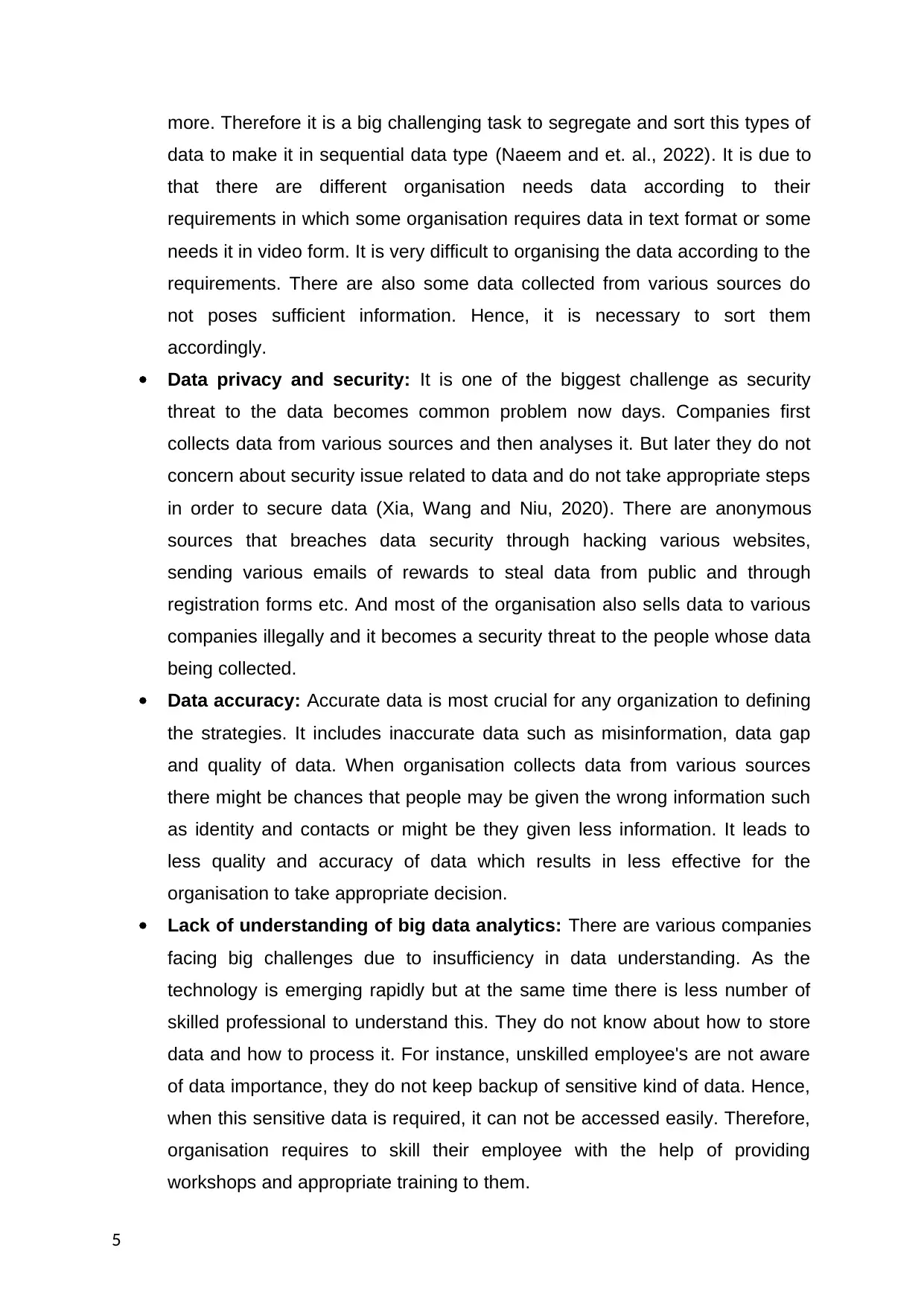
more. Therefore it is a big challenging task to segregate and sort this types of
data to make it in sequential data type (Naeem and et. al., 2022). It is due to
that there are different organisation needs data according to their
requirements in which some organisation requires data in text format or some
needs it in video form. It is very difficult to organising the data according to the
requirements. There are also some data collected from various sources do
not poses sufficient information. Hence, it is necessary to sort them
accordingly.
Data privacy and security: It is one of the biggest challenge as security
threat to the data becomes common problem now days. Companies first
collects data from various sources and then analyses it. But later they do not
concern about security issue related to data and do not take appropriate steps
in order to secure data (Xia, Wang and Niu, 2020). There are anonymous
sources that breaches data security through hacking various websites,
sending various emails of rewards to steal data from public and through
registration forms etc. And most of the organisation also sells data to various
companies illegally and it becomes a security threat to the people whose data
being collected.
Data accuracy: Accurate data is most crucial for any organization to defining
the strategies. It includes inaccurate data such as misinformation, data gap
and quality of data. When organisation collects data from various sources
there might be chances that people may be given the wrong information such
as identity and contacts or might be they given less information. It leads to
less quality and accuracy of data which results in less effective for the
organisation to take appropriate decision.
Lack of understanding of big data analytics: There are various companies
facing big challenges due to insufficiency in data understanding. As the
technology is emerging rapidly but at the same time there is less number of
skilled professional to understand this. They do not know about how to store
data and how to process it. For instance, unskilled employee's are not aware
of data importance, they do not keep backup of sensitive kind of data. Hence,
when this sensitive data is required, it can not be accessed easily. Therefore,
organisation requires to skill their employee with the help of providing
workshops and appropriate training to them.
5
data to make it in sequential data type (Naeem and et. al., 2022). It is due to
that there are different organisation needs data according to their
requirements in which some organisation requires data in text format or some
needs it in video form. It is very difficult to organising the data according to the
requirements. There are also some data collected from various sources do
not poses sufficient information. Hence, it is necessary to sort them
accordingly.
Data privacy and security: It is one of the biggest challenge as security
threat to the data becomes common problem now days. Companies first
collects data from various sources and then analyses it. But later they do not
concern about security issue related to data and do not take appropriate steps
in order to secure data (Xia, Wang and Niu, 2020). There are anonymous
sources that breaches data security through hacking various websites,
sending various emails of rewards to steal data from public and through
registration forms etc. And most of the organisation also sells data to various
companies illegally and it becomes a security threat to the people whose data
being collected.
Data accuracy: Accurate data is most crucial for any organization to defining
the strategies. It includes inaccurate data such as misinformation, data gap
and quality of data. When organisation collects data from various sources
there might be chances that people may be given the wrong information such
as identity and contacts or might be they given less information. It leads to
less quality and accuracy of data which results in less effective for the
organisation to take appropriate decision.
Lack of understanding of big data analytics: There are various companies
facing big challenges due to insufficiency in data understanding. As the
technology is emerging rapidly but at the same time there is less number of
skilled professional to understand this. They do not know about how to store
data and how to process it. For instance, unskilled employee's are not aware
of data importance, they do not keep backup of sensitive kind of data. Hence,
when this sensitive data is required, it can not be accessed easily. Therefore,
organisation requires to skill their employee with the help of providing
workshops and appropriate training to them.
5
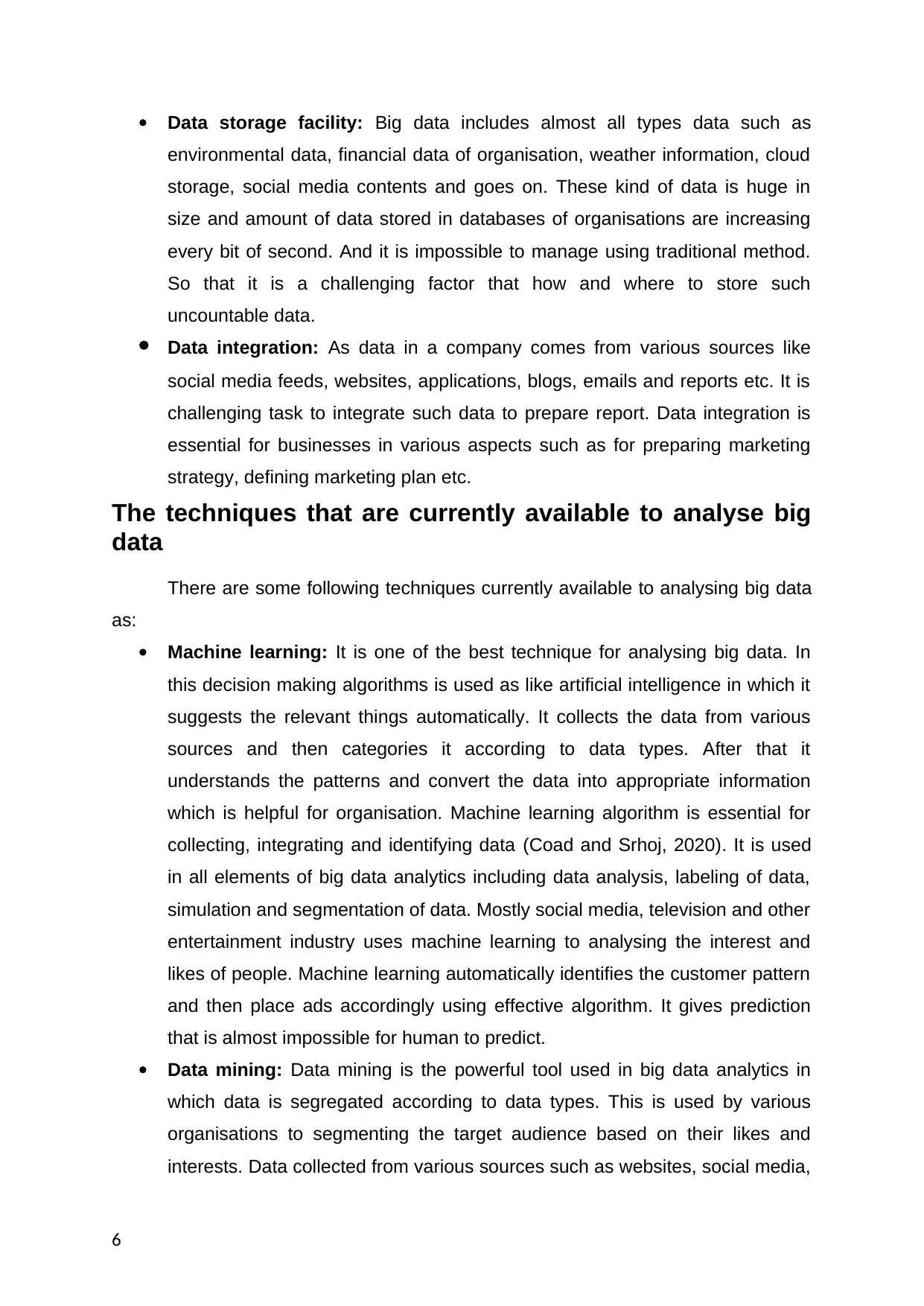
Data storage facility: Big data includes almost all types data such as
environmental data, financial data of organisation, weather information, cloud
storage, social media contents and goes on. These kind of data is huge in
size and amount of data stored in databases of organisations are increasing
every bit of second. And it is impossible to manage using traditional method.
So that it is a challenging factor that how and where to store such
uncountable data.
Data integration: As data in a company comes from various sources like
social media feeds, websites, applications, blogs, emails and reports etc. It is
challenging task to integrate such data to prepare report. Data integration is
essential for businesses in various aspects such as for preparing marketing
strategy, defining marketing plan etc.
The techniques that are currently available to analyse big
data
There are some following techniques currently available to analysing big data
as:
Machine learning: It is one of the best technique for analysing big data. In
this decision making algorithms is used as like artificial intelligence in which it
suggests the relevant things automatically. It collects the data from various
sources and then categories it according to data types. After that it
understands the patterns and convert the data into appropriate information
which is helpful for organisation. Machine learning algorithm is essential for
collecting, integrating and identifying data (Coad and Srhoj, 2020). It is used
in all elements of big data analytics including data analysis, labeling of data,
simulation and segmentation of data. Mostly social media, television and other
entertainment industry uses machine learning to analysing the interest and
likes of people. Machine learning automatically identifies the customer pattern
and then place ads accordingly using effective algorithm. It gives prediction
that is almost impossible for human to predict.
Data mining: Data mining is the powerful tool used in big data analytics in
which data is segregated according to data types. This is used by various
organisations to segmenting the target audience based on their likes and
interests. Data collected from various sources such as websites, social media,
6
environmental data, financial data of organisation, weather information, cloud
storage, social media contents and goes on. These kind of data is huge in
size and amount of data stored in databases of organisations are increasing
every bit of second. And it is impossible to manage using traditional method.
So that it is a challenging factor that how and where to store such
uncountable data.
Data integration: As data in a company comes from various sources like
social media feeds, websites, applications, blogs, emails and reports etc. It is
challenging task to integrate such data to prepare report. Data integration is
essential for businesses in various aspects such as for preparing marketing
strategy, defining marketing plan etc.
The techniques that are currently available to analyse big
data
There are some following techniques currently available to analysing big data
as:
Machine learning: It is one of the best technique for analysing big data. In
this decision making algorithms is used as like artificial intelligence in which it
suggests the relevant things automatically. It collects the data from various
sources and then categories it according to data types. After that it
understands the patterns and convert the data into appropriate information
which is helpful for organisation. Machine learning algorithm is essential for
collecting, integrating and identifying data (Coad and Srhoj, 2020). It is used
in all elements of big data analytics including data analysis, labeling of data,
simulation and segmentation of data. Mostly social media, television and other
entertainment industry uses machine learning to analysing the interest and
likes of people. Machine learning automatically identifies the customer pattern
and then place ads accordingly using effective algorithm. It gives prediction
that is almost impossible for human to predict.
Data mining: Data mining is the powerful tool used in big data analytics in
which data is segregated according to data types. This is used by various
organisations to segmenting the target audience based on their likes and
interests. Data collected from various sources such as websites, social media,
6
⊘ This is a preview!⊘
Do you want full access?
Subscribe today to unlock all pages.

Trusted by 1+ million students worldwide
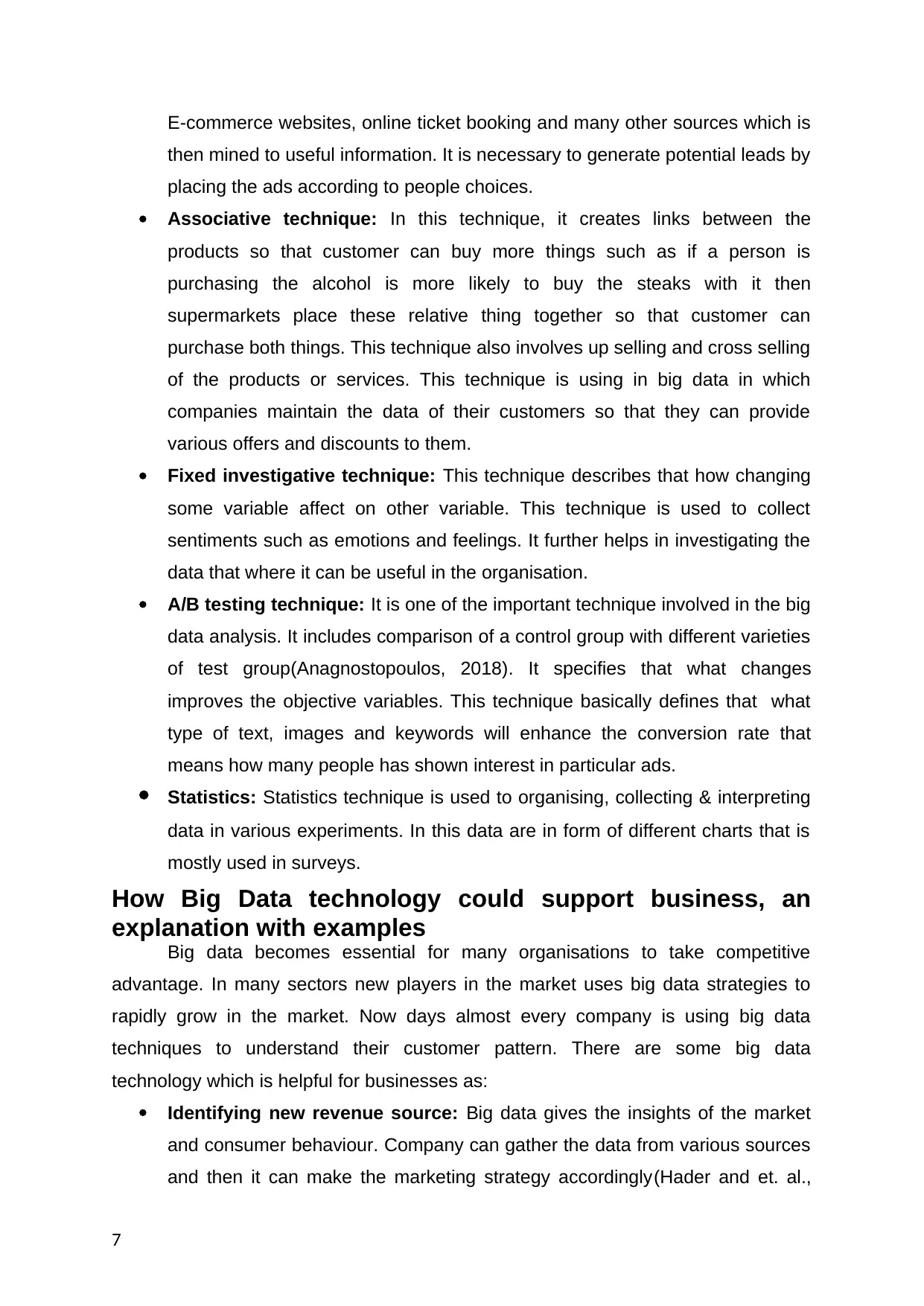
E-commerce websites, online ticket booking and many other sources which is
then mined to useful information. It is necessary to generate potential leads by
placing the ads according to people choices.
Associative technique: In this technique, it creates links between the
products so that customer can buy more things such as if a person is
purchasing the alcohol is more likely to buy the steaks with it then
supermarkets place these relative thing together so that customer can
purchase both things. This technique also involves up selling and cross selling
of the products or services. This technique is using in big data in which
companies maintain the data of their customers so that they can provide
various offers and discounts to them.
Fixed investigative technique: This technique describes that how changing
some variable affect on other variable. This technique is used to collect
sentiments such as emotions and feelings. It further helps in investigating the
data that where it can be useful in the organisation.
A/B testing technique: It is one of the important technique involved in the big
data analysis. It includes comparison of a control group with different varieties
of test group(Anagnostopoulos, 2018). It specifies that what changes
improves the objective variables. This technique basically defines that what
type of text, images and keywords will enhance the conversion rate that
means how many people has shown interest in particular ads.
Statistics: Statistics technique is used to organising, collecting & interpreting
data in various experiments. In this data are in form of different charts that is
mostly used in surveys.
How Big Data technology could support business, an
explanation with examples
Big data becomes essential for many organisations to take competitive
advantage. In many sectors new players in the market uses big data strategies to
rapidly grow in the market. Now days almost every company is using big data
techniques to understand their customer pattern. There are some big data
technology which is helpful for businesses as:
Identifying new revenue source: Big data gives the insights of the market
and consumer behaviour. Company can gather the data from various sources
and then it can make the marketing strategy accordingly(Hader and et. al.,
7
then mined to useful information. It is necessary to generate potential leads by
placing the ads according to people choices.
Associative technique: In this technique, it creates links between the
products so that customer can buy more things such as if a person is
purchasing the alcohol is more likely to buy the steaks with it then
supermarkets place these relative thing together so that customer can
purchase both things. This technique also involves up selling and cross selling
of the products or services. This technique is using in big data in which
companies maintain the data of their customers so that they can provide
various offers and discounts to them.
Fixed investigative technique: This technique describes that how changing
some variable affect on other variable. This technique is used to collect
sentiments such as emotions and feelings. It further helps in investigating the
data that where it can be useful in the organisation.
A/B testing technique: It is one of the important technique involved in the big
data analysis. It includes comparison of a control group with different varieties
of test group(Anagnostopoulos, 2018). It specifies that what changes
improves the objective variables. This technique basically defines that what
type of text, images and keywords will enhance the conversion rate that
means how many people has shown interest in particular ads.
Statistics: Statistics technique is used to organising, collecting & interpreting
data in various experiments. In this data are in form of different charts that is
mostly used in surveys.
How Big Data technology could support business, an
explanation with examples
Big data becomes essential for many organisations to take competitive
advantage. In many sectors new players in the market uses big data strategies to
rapidly grow in the market. Now days almost every company is using big data
techniques to understand their customer pattern. There are some big data
technology which is helpful for businesses as:
Identifying new revenue source: Big data gives the insights of the market
and consumer behaviour. Company can gather the data from various sources
and then it can make the marketing strategy accordingly(Hader and et. al.,
7
Paraphrase This Document
Need a fresh take? Get an instant paraphrase of this document with our AI Paraphraser
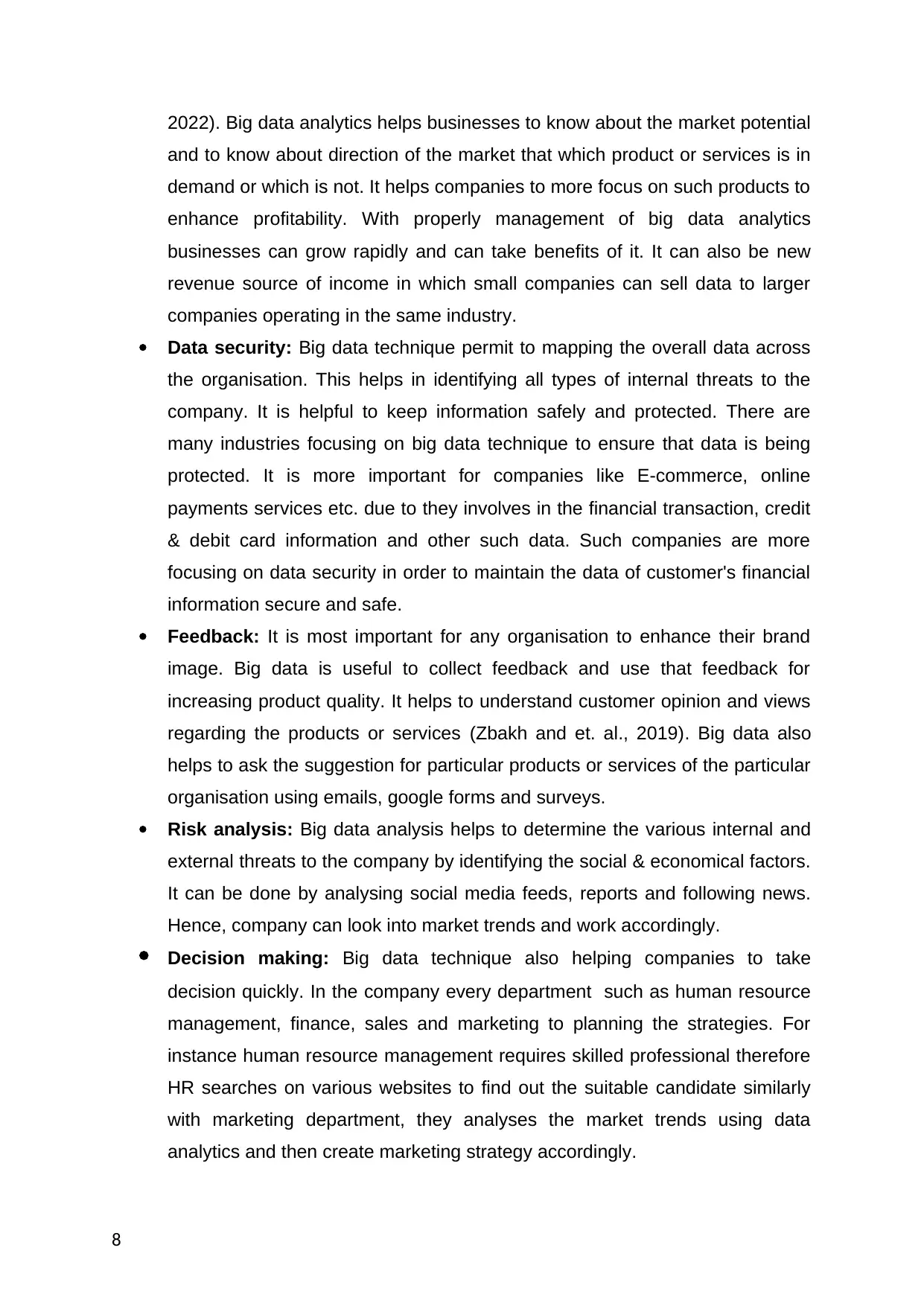
2022). Big data analytics helps businesses to know about the market potential
and to know about direction of the market that which product or services is in
demand or which is not. It helps companies to more focus on such products to
enhance profitability. With properly management of big data analytics
businesses can grow rapidly and can take benefits of it. It can also be new
revenue source of income in which small companies can sell data to larger
companies operating in the same industry.
Data security: Big data technique permit to mapping the overall data across
the organisation. This helps in identifying all types of internal threats to the
company. It is helpful to keep information safely and protected. There are
many industries focusing on big data technique to ensure that data is being
protected. It is more important for companies like E-commerce, online
payments services etc. due to they involves in the financial transaction, credit
& debit card information and other such data. Such companies are more
focusing on data security in order to maintain the data of customer's financial
information secure and safe.
Feedback: It is most important for any organisation to enhance their brand
image. Big data is useful to collect feedback and use that feedback for
increasing product quality. It helps to understand customer opinion and views
regarding the products or services (Zbakh and et. al., 2019). Big data also
helps to ask the suggestion for particular products or services of the particular
organisation using emails, google forms and surveys.
Risk analysis: Big data analysis helps to determine the various internal and
external threats to the company by identifying the social & economical factors.
It can be done by analysing social media feeds, reports and following news.
Hence, company can look into market trends and work accordingly.
Decision making: Big data technique also helping companies to take
decision quickly. In the company every department such as human resource
management, finance, sales and marketing to planning the strategies. For
instance human resource management requires skilled professional therefore
HR searches on various websites to find out the suitable candidate similarly
with marketing department, they analyses the market trends using data
analytics and then create marketing strategy accordingly.
8
and to know about direction of the market that which product or services is in
demand or which is not. It helps companies to more focus on such products to
enhance profitability. With properly management of big data analytics
businesses can grow rapidly and can take benefits of it. It can also be new
revenue source of income in which small companies can sell data to larger
companies operating in the same industry.
Data security: Big data technique permit to mapping the overall data across
the organisation. This helps in identifying all types of internal threats to the
company. It is helpful to keep information safely and protected. There are
many industries focusing on big data technique to ensure that data is being
protected. It is more important for companies like E-commerce, online
payments services etc. due to they involves in the financial transaction, credit
& debit card information and other such data. Such companies are more
focusing on data security in order to maintain the data of customer's financial
information secure and safe.
Feedback: It is most important for any organisation to enhance their brand
image. Big data is useful to collect feedback and use that feedback for
increasing product quality. It helps to understand customer opinion and views
regarding the products or services (Zbakh and et. al., 2019). Big data also
helps to ask the suggestion for particular products or services of the particular
organisation using emails, google forms and surveys.
Risk analysis: Big data analysis helps to determine the various internal and
external threats to the company by identifying the social & economical factors.
It can be done by analysing social media feeds, reports and following news.
Hence, company can look into market trends and work accordingly.
Decision making: Big data technique also helping companies to take
decision quickly. In the company every department such as human resource
management, finance, sales and marketing to planning the strategies. For
instance human resource management requires skilled professional therefore
HR searches on various websites to find out the suitable candidate similarly
with marketing department, they analyses the market trends using data
analytics and then create marketing strategy accordingly.
8
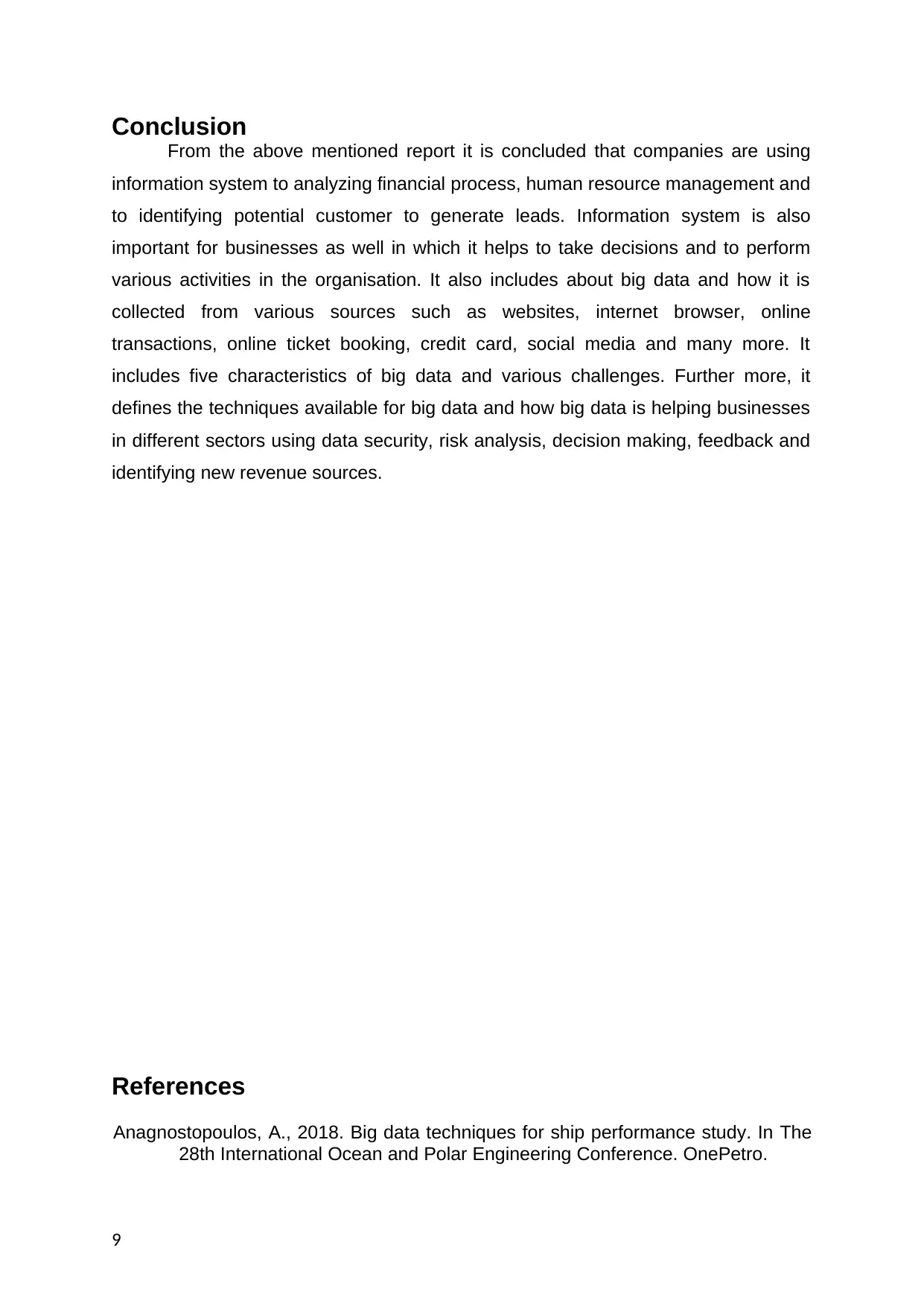
Conclusion
From the above mentioned report it is concluded that companies are using
information system to analyzing financial process, human resource management and
to identifying potential customer to generate leads. Information system is also
important for businesses as well in which it helps to take decisions and to perform
various activities in the organisation. It also includes about big data and how it is
collected from various sources such as websites, internet browser, online
transactions, online ticket booking, credit card, social media and many more. It
includes five characteristics of big data and various challenges. Further more, it
defines the techniques available for big data and how big data is helping businesses
in different sectors using data security, risk analysis, decision making, feedback and
identifying new revenue sources.
References
Anagnostopoulos, A., 2018. Big data techniques for ship performance study. In The
28th International Ocean and Polar Engineering Conference. OnePetro.
9
From the above mentioned report it is concluded that companies are using
information system to analyzing financial process, human resource management and
to identifying potential customer to generate leads. Information system is also
important for businesses as well in which it helps to take decisions and to perform
various activities in the organisation. It also includes about big data and how it is
collected from various sources such as websites, internet browser, online
transactions, online ticket booking, credit card, social media and many more. It
includes five characteristics of big data and various challenges. Further more, it
defines the techniques available for big data and how big data is helping businesses
in different sectors using data security, risk analysis, decision making, feedback and
identifying new revenue sources.
References
Anagnostopoulos, A., 2018. Big data techniques for ship performance study. In The
28th International Ocean and Polar Engineering Conference. OnePetro.
9
⊘ This is a preview!⊘
Do you want full access?
Subscribe today to unlock all pages.

Trusted by 1+ million students worldwide
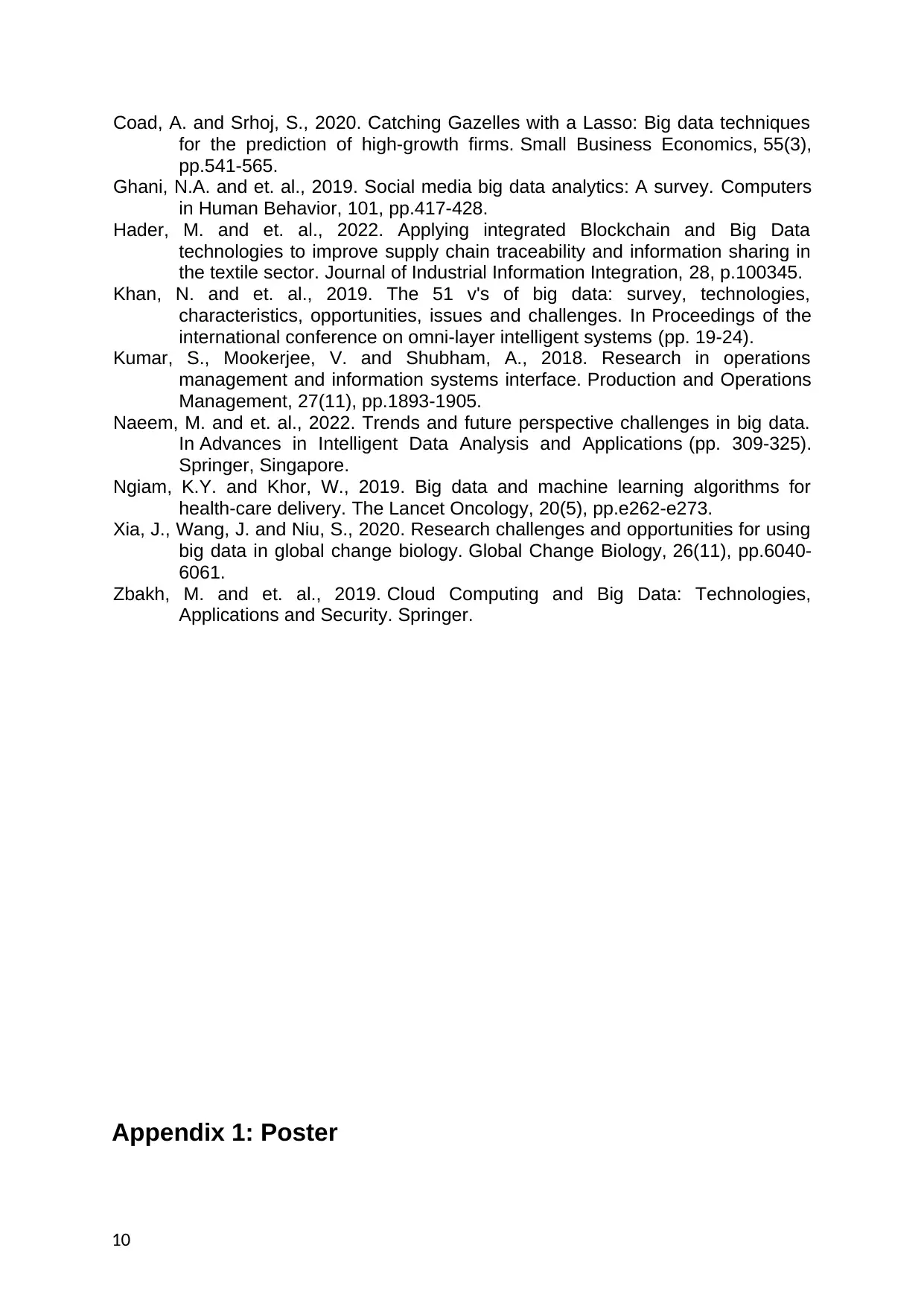
Coad, A. and Srhoj, S., 2020. Catching Gazelles with a Lasso: Big data techniques
for the prediction of high-growth firms. Small Business Economics, 55(3),
pp.541-565.
Ghani, N.A. and et. al., 2019. Social media big data analytics: A survey. Computers
in Human Behavior, 101, pp.417-428.
Hader, M. and et. al., 2022. Applying integrated Blockchain and Big Data
technologies to improve supply chain traceability and information sharing in
the textile sector. Journal of Industrial Information Integration, 28, p.100345.
Khan, N. and et. al., 2019. The 51 v's of big data: survey, technologies,
characteristics, opportunities, issues and challenges. In Proceedings of the
international conference on omni-layer intelligent systems (pp. 19-24).
Kumar, S., Mookerjee, V. and Shubham, A., 2018. Research in operations
management and information systems interface. Production and Operations
Management, 27(11), pp.1893-1905.
Naeem, M. and et. al., 2022. Trends and future perspective challenges in big data.
In Advances in Intelligent Data Analysis and Applications (pp. 309-325).
Springer, Singapore.
Ngiam, K.Y. and Khor, W., 2019. Big data and machine learning algorithms for
health-care delivery. The Lancet Oncology, 20(5), pp.e262-e273.
Xia, J., Wang, J. and Niu, S., 2020. Research challenges and opportunities for using
big data in global change biology. Global Change Biology, 26(11), pp.6040-
6061.
Zbakh, M. and et. al., 2019. Cloud Computing and Big Data: Technologies,
Applications and Security. Springer.
Appendix 1: Poster
10
for the prediction of high-growth firms. Small Business Economics, 55(3),
pp.541-565.
Ghani, N.A. and et. al., 2019. Social media big data analytics: A survey. Computers
in Human Behavior, 101, pp.417-428.
Hader, M. and et. al., 2022. Applying integrated Blockchain and Big Data
technologies to improve supply chain traceability and information sharing in
the textile sector. Journal of Industrial Information Integration, 28, p.100345.
Khan, N. and et. al., 2019. The 51 v's of big data: survey, technologies,
characteristics, opportunities, issues and challenges. In Proceedings of the
international conference on omni-layer intelligent systems (pp. 19-24).
Kumar, S., Mookerjee, V. and Shubham, A., 2018. Research in operations
management and information systems interface. Production and Operations
Management, 27(11), pp.1893-1905.
Naeem, M. and et. al., 2022. Trends and future perspective challenges in big data.
In Advances in Intelligent Data Analysis and Applications (pp. 309-325).
Springer, Singapore.
Ngiam, K.Y. and Khor, W., 2019. Big data and machine learning algorithms for
health-care delivery. The Lancet Oncology, 20(5), pp.e262-e273.
Xia, J., Wang, J. and Niu, S., 2020. Research challenges and opportunities for using
big data in global change biology. Global Change Biology, 26(11), pp.6040-
6061.
Zbakh, M. and et. al., 2019. Cloud Computing and Big Data: Technologies,
Applications and Security. Springer.
Appendix 1: Poster
10
Paraphrase This Document
Need a fresh take? Get an instant paraphrase of this document with our AI Paraphraser
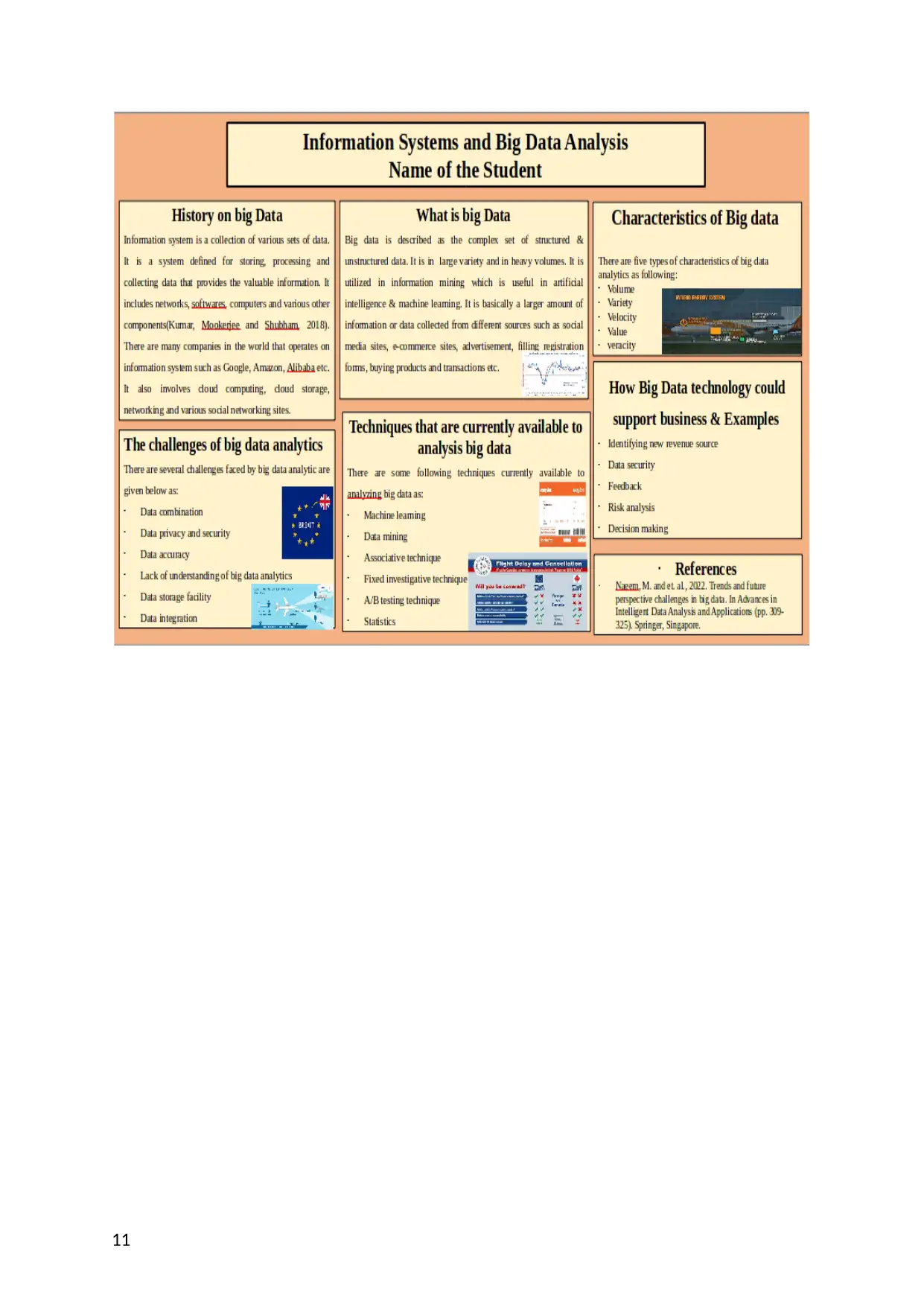
11
1 out of 11
Related Documents
Your All-in-One AI-Powered Toolkit for Academic Success.
+13062052269
info@desklib.com
Available 24*7 on WhatsApp / Email
![[object Object]](/_next/static/media/star-bottom.7253800d.svg)
Unlock your academic potential
Copyright © 2020–2025 A2Z Services. All Rights Reserved. Developed and managed by ZUCOL.



